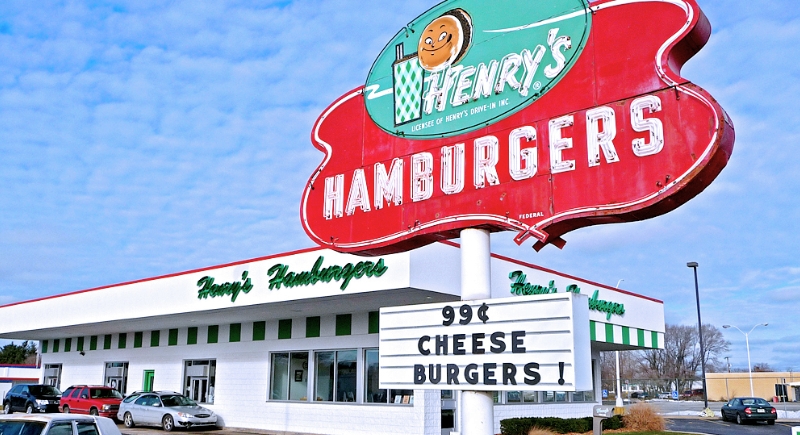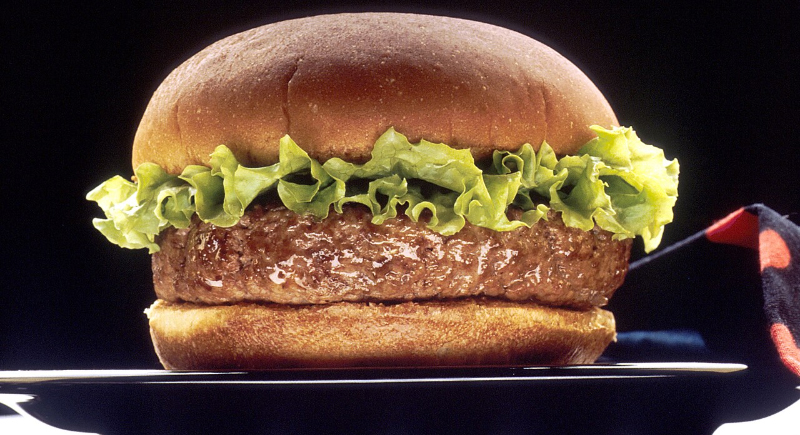There Was a Burger Chain That Was Once Bigger Than McDonald’s and It Just Vanished
It’s hard to imagine a time when the golden arches didn’t define American fast food. However, before McDonald’s became a worldwide icon, another burger chain briefly held the spotlight along America’s highways, drive-ins, and neon-lit corners of the 1950s. Its burgers were cheap, its fries famously generous, and on a good day, a family could eat for less than the cost of a night at the movies.
Then, just as quickly as it grew, it faded away, leaving behind only one surviving location. That chain was Henry’s Hamburgers, a once-prominent competitor that expanded rapidly during the early years of fast food. Today, it is remembered by those who still talk about its “ten burgers for a buck” deal and its roadside charm.
Born in the Burger Boom

Image via Wikimedia Commons/Beached Bum
The 1950s marked a golden age for roadside dining. With more families hitting the highways, carhops and drive-ins became part of everyday life. Bresler’s Ice Cream Company, already successful in frozen desserts, saw a new opportunity. In 1954, it opened the first Henry’s Hamburgers in Chicago, aiming to pair its ice cream with something hot off the griddle.
It was named after the company’s cofounder, Henry Bresler, and the chain expanded quickly. By the early 1960s, there were more than 200 Henry’s restaurants across the United States, more than McDonald’s had at that time.
Hamburgers sold for about 15 cents, fries for a dime, and milkshakes rounded out the offerings. Some locations even featured fish sandwiches, shrimp, and seafood platters promoted as “the adult menu that kids love.”
When Drive-Ins Defined the Road
Henry’s early success came from timing. The chain thrived during the height of drive-in culture, when families preferred to dine from their cars rather than sit inside. Its “ten burgers for a buck” promotion became a signature deal that drew in parents who wanted to feed everyone quickly and cheaply.
As the 1960s progressed, the fast-food landscape changed. Drive-ins gave way to drive-thrus, and chains like McDonald’s began streamlining operations to emphasize speed and consistency. Henry’s stayed loyal to its drive-in setup and missed the shift toward faster, more standardized service. The gap between Henry’s and its competitors widened as the decade went on.
By the 1970s, Henry’s was struggling. Bresler’s, its parent company, faced its own business challenges, including mergers and management changes that left the restaurant division adrift. The chain never adapted to the new drive-thru model, which had become central to modern fast food.
During this time, a rumor spread around Chicago claiming that some Henry’s locations used horse meat in their burgers. There was never any proof, but the story damaged the brand’s reputation. Combined with corporate instability, the rumor accelerated the decline. Within a few years, most Henry’s restaurants had closed, and their familiar “H” signs disappeared from the roadside.
The Last Henry Standing

Image via Wikimedia Commons/Len Rizzi
One Henry’s Hamburgers still operates today in Benton Harbor, Michigan. It opened in 1959 and survived by focusing on local customers rather than corporate systems. While the company disappeared, this independently owned restaurant continued serving classic food at reasonable prices.
In 1988, the Benton Harbor location added a drive-thru to adapt without losing its identity. The menu still includes burgers, fries by the half-pound, shakes, chili dogs, and fried catfish.
The chain may not have survived the fast-food boom it helped inspire, but its story remains a part of that history.